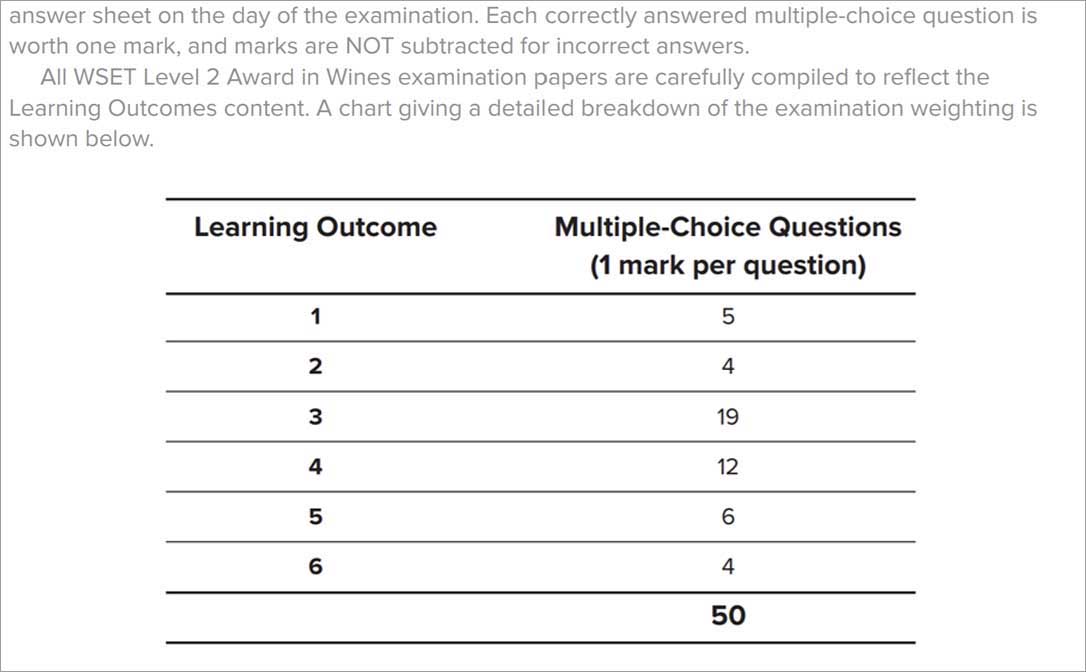There is so much that goes into preparing to take a WSET exam, at any level and in any subject stream. The most obvious advice for candidates is to read the qualification specification, attend class and read your textbook.
For many candidates, this is enough to ensure success. But as you move up through the levels, and out of range of your pre-existing knowledge and expertise, failure or success can come down to more than just your familiarity with the subject matter. It can come down to your mastery of exam technique.
Understanding the exam format
Knowledge itself is essential, but success may depend in large part on your understanding of the format of your exam:
- How it will be graded
- What are the markers looking for
- What are the markers not looking for
On multiple-choice questions (the question format for our exams at Levels 1 and 2, and that makes up part of the theory paper at Level 3), try to understand how these are usually written so that you can more aptly “rule out” certain choices. Remember that there’s no penalty for guessing – in fact doing so can make all the difference between passing and failing. It’s always best to put down an answer, even if you’re not sure.
Let’s say you’re sitting a Level 2 Award in Spirits exam, which consists of 50 multiple-choice questions. You confidently and definitively know the answer to 20 of those questions. As the pass rate is 55%, you would need to take a guess at the other 30 to be in with a chance of passing.
So, what happens if you do guess? If there are four choices, you have a one in four chance of getting the right answer on a ‘wild guess’. You might get enough right to take you over the 55% threshold, but it’s a gamble.
Pro tip: start with the questions you can readily answer. This will help to build your confidence and you can then devote your remaining exam time to thinking through the questions you’re not so sure about.
But what if you are able to rule out at least one of the choices for each of those questions – something you know is definitely wrong? Now your guess has at least a 1 in 3 chance of being correct. Guessing those answers correctly gives you a much better chance at getting 30 out of 50, which is safely in the pass column. Knowing these simple statistics can make a big difference!
How to prioritise your revision
Every WSET qualification has an accompanying specification document which covers recommended tasting samples, examination guidance and ‘learning outcomes’ – this is essential reading before and during your course!
Learning outcomes are essentially what a student should expect to know and be able to do once they have successfully completed the qualification. Not only do these specifications tell you what topics could be covered in the exam, they also tell you how many questions you will see relating to each of the learning outcomes.
How does this help you? This time let’s take the Level 2 Award in Wines examination as an example. The specification tells you that exactly 19 of the 50 questions will be on topics from Learning Outcome 3, which is “Understand how environmental influences, grape-growing options, winemaking and bottle ageing influence the style and quality of wines made from the principal grape varieties”.
By comparison, only 4 of the 50 questions will cover Learning Outcome 6, which is “Understand the key principles and processes involved in the storage and service of wine, and in the pairing of food and wine.”

A detailed breakdown of the examination weighting for the Level 2 Award in Wines based on the learning outcomes.
Should you be familiar with the topics in Learning Outcome 6? Definitely. But if for some reason you found yourself with limited time to study (as most of us do!), knowing which outcome areas have the most questions would ensure you maximise the effectiveness of your remaining study time.
How to read the questions
With a multiple-choice question, you know with 100% certainty how that question will be marked. WSET’s Level 3 and Level 4 examinations include other question types which may be less obvious. A truly prepared exam taker goes beyond preparing to answer questions, they prepare how to answer them.
Look for the command verb
All short answer questions will contain a very important word known as a ‘command verb’ - these words give you an idea of what level of detail you will need to go into to achieve marks. They include terms such as identify, list, describe, compare, discuss, explain, evaluate, identify and analyse.
Inexperienced exam takers, when faced with a question, might go straight to the topic the question addresses – say, the Loire Valley – and start writing down all the facts they know about the Loire. They may accidentally get a few marks, but this is not a strategy for success.
Pro tip: When you read through your question paper, look for the command verbs, circle or underline them, and take a moment to consider what they are ‘commanding’ you to do.
Skilled exam takers pay close attention to the command verbs used in a question. What is the question really asking? If the command verb “list” is used, then the answer must consist of a list of facts. If the command verb “describe” is used, then the answer must consist of a description. If “compare” is used, the answer must provide a proper comparison between at least two things. If “explain” is used, then the answer must tell the marker how and/or why certain factors affect an outcome. The command verb tells you what the marker will be looking for in your answer.
How many marks are available?
The exam papers always state the number of marks or points that can be awarded by the marker for a particular question. In constructing an answer to any question, you should pay attention to these clues. For example, if a question using the command verb “list” says it has a maximum of three marks, you should list at least three correct things! Failing to do so is leaving points on the table. On the other hand, you shouldn’t need to list ten things. As soon as the marker gives you the third point, they stop reading. There is no extra credit here, and time is precious during your exam. You should plan to use every minute to get every possible point, which means no wasting time!
For Level 3 qualifications, the study guide is an invaluable resource. It goes into some depth explaining how questions are structured and it offers examples of short answer questions together with their answers.
In conclusion…
Preparing for your WSET exam is serious business, at any level and in any category. You now know that to maximise your success, you need to strategise - not just memorise.
We recommend you rely on the official documents available on WSET’s website. Because WSET constantly reviews and updates qualifications and exams, there is much inaccurate information floating around the internet that is based on older exams that are out-of-date. There is no better source of guidance than the course provider you study with. They will always have access to the current documentation from WSET, and because of the number of candidates they work with, and their extensive experience offering WSET exams, they will have built up plenty of wisdom over time that they can share with you.
Best of luck in your studies!
Prepared by Dave Rudman DipWSET, Executive Director WSET Americas
If you’ve not yet signed up for a course, visit our Where to Study page to find the right course provider for you!


